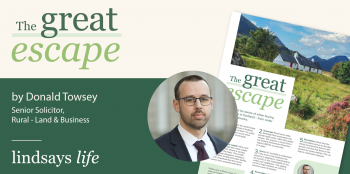Succession is one of the biggest issues in agriculture. And - as the demographic of Scotland’s farmers becomes older - many face significant decisions about their future, whether they own the land on which they farm, or whether they are tenants.
There has been no escaping headline-grabbing issues surrounding the UK Government’s controversial decisions around Inheritance Tax, a change which is going to have a significant impact on succession planning for many land-based enterprises and family businesses more widely.
That’s a complex discussion for another issue . . . This time around, we are focusing on succession considerations for tenant farmers.
The issue of succession for tenant farmers can be equally as complex as those who own their farms, especially if they are considering retirement and calculating both whether and when they can afford to do so.
At the same time, we are seeing increasing numbers of landlords keen to take land back in-hand so that they have greater day-to-day control over its use. Tenants too are realising the value of their tenancy.
As all of this becomes more common, issues around relinquishment and assignation are increasingly coming to the fore. But, with the legal framework relatively new, this is new territory for many.
Tenants, particularly those with a “secure” tenancy under the Agricultural Holdings (Scotland) Act 1991 are in possession of a valuable asset.
As is widely known, these tenancies can be transferred to family members - a factor which is critical to the continuity of many farming businesses.
But, for those where the next generation has decided to work away from the family farm and there is no successor, there is the option of ending their tenancy. It is the detail of this which is less widely known.
The Land Reform (Scotland) Act 2016 introduced the right for tenants to relinquish their tenancy - in return for a payment from their landlord - or if the landlord does not wish to buy the tenancy back, to assign it to someone else, a move designed to give a lift to new entrants into agriculture and progressing farmers. These provisions came into effect in 2021.
Relinquishment is ultimately about financially supporting tenants with leases under the 1991 Act who wish to retire to ensure they can do so by recognising the value of their asset. It is proving a critical pension pot for many entering the next stage in their life.
The payment made to the tenant under a relinquishment process is calculated via a complex valuation exercise set out in the legislation.
Secure tenants can begin the process of relinquishment provided that they haven’t failed to comply with the terms of their lease and neither the landlord or the tenant has served a notice to quit on the other.
Following an initial informal discussion with their landlord, tenants wishing to go down the formal relinquishment process should serve a Notice of Intention to Relinquish to their landlord, and copy this to the Tenant Farming Commissioner. The latter will appoint an independent valuer to carry out the valuation work.
If agreement cannot be reached with a landlord regarding valuation, the tenant can instead assign the lease to a “new entrant” or “progressing farmer”. Definitions of both are defined in the legislation - albeit there are legal provisions in place for landlords to object to a new tenant based on certain grounds, including skills and their ability to pay rent owed.
With assignation, the departing tenant would again be paid for this. Given the competitiveness of the Scottish land market, that payment may be considerable, particularly as the value at which the tenancy can be sold to new entrants or progressing farmers is not specified.
As increasing numbers consider their options in respect of the future of their agricultural tenancies, it is possible for landlords and tenants to try to agree terms between themselves without following the formal relinquishment process, but we would always advise using the legislation as a guide and taking professional advice.
The affordability of retirement has long been a challenge for farmers, particularly those with tenancies. For many, relinquishment and assignation could be the answer to that.
For landowners keen to take land back in-hand - perhaps to farm themselves or pursue diversification opportunities - the process also offers opportunity.
Published 28 May 2025






